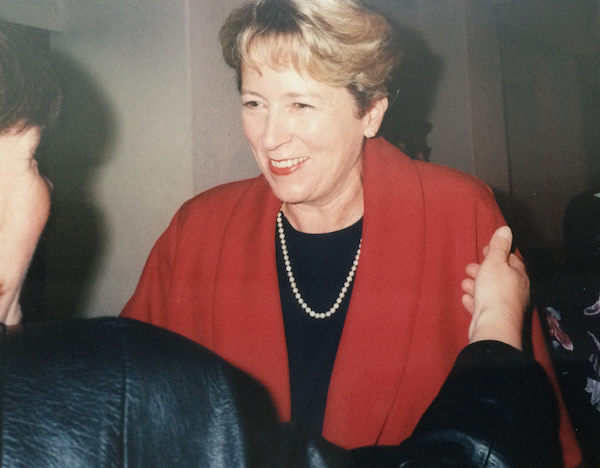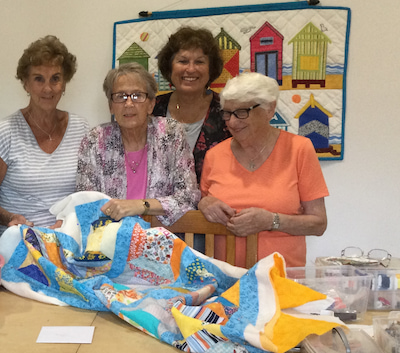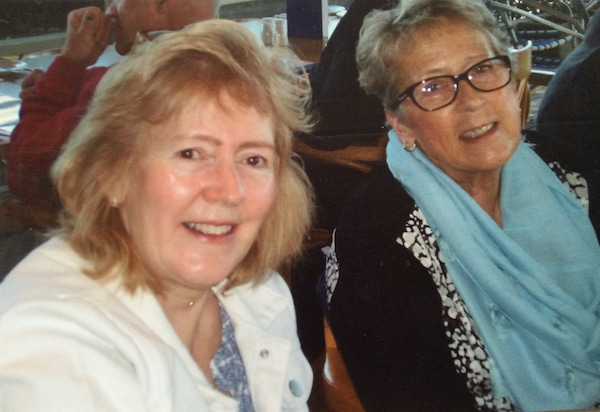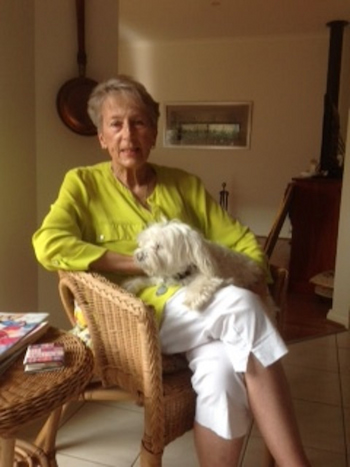Janice has “been just so lucky” over the 12 years she’s had myeloma
Had Janice Watt been diagnosed with myeloma two years earlier, “I wouldn’t be here”, she says, because “everything has just been discovered as I’ve needed it”.
“I’ve just been so, so lucky,” said Janice, 73, of Melbourne.
“I’ve done really well to live as long as I have.”

She was diagnosed with stage III myeloma in February 2009 when she was 61. In the 12 years since, she’s had two stem cell transplants (SCT), a cocktail of therapies, and “a few times when I’ve been pretty sick” and when Janice nearly didn’t survive to share her story. And, between her first and second transplant, she was diagnosed, treated, and has survived breast cancer as well!
Life before myeloma
“I had a lovely little life,” said Janice summing up her day-to-day life before the appearance of myeloma symptoms.
“I was working four days a week as a conveyancer, played golf two days a week, felt well, and was very fit.”
Then, she changed jobs and suddenly found herself running the conveyancing office while her boss had major heart surgery.
“I got stressed and had a lot of pain in my back, so I couldn’t play golf.
“I kept going to doctors, and was told I needed counselling, and I went to physios who said there was nothing wrong with me, but I couldn’t get off the treatment table!
“I couldn’t get out of bed and I was crawling to the toilet.
“I was in severe pain, it was unbelievable,” said Janice who went back to the GP and said, “look, I’ve got to have an x-ray or something”.
After organising for Janice to have a back scan, he called her into the office and told her, “you’ve got bone cancer, you’re dying, there’s nothing you can do about it”.
Janice’s diagnosis and starting treatment
She was referred to an oncologist and went to hospital for tests.
“A lovely doctor came and said, “there’re so many types of bone cancer. We can’t fix any of them except for this one that you’ve got, it’s called multiple myeloma”.
“He sent me off to Miles [Professor Miles Prince], thank god. He did a lot of other tests and set down a time for me to have a stem cell transplant.
“He said, ‘that’s what we have to do’ and explained how it reduces your myeloma.
“My paraprotein was over 60 and we had to get that down so that I could live,” said Janice.
She went back to hospital in March/April for three weeks, when she had chemo before her stem cells were harvested, then she was given melphalan prior to her stem cells being reinfused.
“Before Miles let me go home, he said, ‘I want you to have another one [SCT]’.
“I said, ‘I’m done with it’, and he said, ‘you don’t have to have it now, we’ll just wait and see how things go’.”
Janice’s diagnosis with breast cancer on top of having myeloma
“Things settled down. Then, in June, lying in bed one morning, I knocked my breast and there was a great big lump.
“I went to my GP–I had a new GP by then–who sent me off for tests, and I called Miles, and he said, ‘I want to see you tomorrow’.”
Janice had breast cancer.
“Miles was quite surprised, because one of the drugs I was taking was a breast cancer drug.”
He referred Janice to a breast cancer specialist, “the most magnificent man, I didn’t want to let him go after 10 years”, who put her straight in hospital for a lumpectomy, further surgery to remove some lymph nodes, then radiotherapy before she got the ‘all clear’.
After Janice recovered, she was told it was time to have her second stem cell transplant, which she had in September 2009.
“I’m very lucky, I didn’t have any side effects from both transplants, just one time during the second one when I got really, really cold. They just had to warm me up and that was it.”
“I came home, and I got better, and by February [2010] I was playing golf.”

Getting on with life after her two transplants
Janice had monthly appointments with Prof. Prince and wasn’t on any treatment.
“We’d chatter about the football and he’d say how’s St Kilda going, and how’s your dog?
“We still do, unless there’s something wrong. When it goes pear-shaped, which it does, we have a serious talk and he changes the medication. But mostly we have a nice time.”
The following year, Janice’s paraprotein “started to wobble a bit” and she started thalidomide maintenance.
“I got neuropathy and I put up with it until in the end I said, ‘I can’t do this anymore’,” said Janice.
She stopped the thalidomide and again stayed off treatment for a while.
“I had some holidays and played my golf,” said Janice, who went on The Ghan, and to Perth, and had a couple of trips to Noosa, “which I dream of doing again”.
“I had what I thought was going to be a nice retirement until I went to him [Prof. Prince] one day and he said,’ it’s moving, so off we go’.
“He thinks about it and works out what he’s going to do.
“We’ve won all the way along. I’ve just been so lucky to have a good doctor like that. I’ve learnt there are quite a lot of doctors of his skill, but I am very lucky to have him.”
When Janice’s myeloma started progressing, in August 2013, she started lenalidomide (Revlimid®) and prednisolone. Then, when her paraprotein started to slowly progress again, in October 2016, elotuzumab (Empliciti®) was added to the treatment regimen the following month, along with dexamethasone. And, in early 2017, Janice also started taking carfilzomib (Kyprolis®).
“That involved two days of treatment a week for three weeks and then one week off. It was in the city, so by the time I got driven home on the second day, I was practically dead,” said Janice, who lived 44km from the treatment centre at East Melbourne.
“I don’t know how I did it, but you just do it,” she said about this regimen that continued for six months.
“Then I went to two weeks on and two weeks off, which I thought was heaven.”
During this time, she moved from being treated at East Melbourne, to Brighton, which was closer to home.
Taking the stress out of getting to and from treatment
Prof. Prince had suggested Janice contact the Leukaemia Foundation about transport to and from her treatment sessions.
“I got in touch and we organised for them to pick me up, but I had to be finished by 3pm,” said Janice about her return journey.
“The Leukaemia Foundation was great. They picked me up on time and had lovely drivers.
“My problem was I had to have finished my treatment by 3pm and often that wasn’t possible, so I had to catch a taxi.
“Then, because of my [chemo] brain, by the time I worked out my tablets, and worked out who was driving when and where, and all of that, because I was having so much treatment, I was just beside myself.
“Friends and family would say, ‘oh, well, I’ll take you”, but it’s still organising people and I just couldn’t do it, and I used to be very good at organising things.
“One day, almost at the beginning of having carfilzomib, I got picked up by this taxi driver, Harry, and we started chatting, and he said, ‘I’ll look after you’, and he makes sure there’s a taxi waiting for me when I finish.
“I’d just ring him, or text him now, and say, ‘it’s on again, pick me up, blah, blah, blah’, and I never have to think about it or worry about it. It makes such a difference,” said Janice, who is eligible for half-price taxi fares from the Government.
“That took so much pressure off.
“I’m in a myeloma group and I’ve come across a lot of people in that time whose families work. They can’t all be at their beck and call driving you everywhere.
“So, I was very lucky to get Harry.”

Adding daratumumab to her treatment regimen
Treatment with carfilzomib was discontinued in March 2018, and the following month Janice started daratumumab, combined with the lenalidomide and dexamethasone.
“You’ve got to go through all the different drugs before they’ll let you have the next one,” said Janice about being granted compassionate access to daratumumab.
“I started that and had to go back to East Melbourne. That was weekly, then fortnightly–when I went back to Brighton–and now monthly.
“That’s what turned the corner for me and that’s going really well.
“I can’t tell you how quickly my paraprotein went down, and now I’ve got a normal life.”
“I just go month to month, and when I see Miles, and we start talking football and everything, I know I’m okay for another month.”
“I go in to see Miles at 8-8:15 in the morning, then Harry the taxi driver takes me to Brighton and I have 20 mg of dexamethasone and all the other treatments. I leave there about 4:30-5 at night. I have a really long day, but it gets it all out of the way in one day.
“I’ve been on everything,” said Janice describing the number of different treatments she’s had over the years.
In early 2019, she started cyclophosphamide, she also has Intragam®, and every three months, the bone strengthener, Zometa®.
“I’ve been on that a long time. I’ve got a bit of osteo in my arms, and I’ve really shrunk.
“My back is terrible, and I have a hump now, which I hate, because of the bone damage.
“I’ve gone from 5’8″ [172cm] to 5’2″ [157cm],” said Janice, and to help with her pain, she’s on a low dose of methadone.
Getting on with life living with myeloma
When Janice spoke to Myeloma News, she was looking forward to going out the following night to see a live show, an Elvis impersonator.
She goes out for lunch with friends every fortnight, she takes her rescue Maltese dog, Bella, for walks daily, is a member of Probus, and is secretary of the Beaumaris myeloma support group.
Janice also spends “a fair bit of time doing patchwork”. For many years she has run a patchwork group that gathers once a week at her place to make quilts that are donated to charities for fundraising.
And she does some light gardening because she enjoys it but, “my back kills me so I can only do 10 minutes, then I’ve got to have a rest”.
Janice had to give her golf away because of COVID, and now enjoys doing exercises to music.
Since starting daratumumab, Janice has not been interested in eating, has lost a lot of weight and has struggled to put on weight. In recent years, she has also become lactose intolerant, gets puffed easily, and lives with fatigue and bowel problems.
Janice describes having myeloma as “very much a learning experience”.
“It’s not the worst thing in the world. I don’t have the world’s greatest life, but I have a good life.”
“I wish I hadn’t had myeloma, of course, it’s nothing like the retirement I wanted.
“I do get down sometimes, but you’ve only got to look at someone in a wheelchair, or something, and you come back up again pretty quick.
“I’ve been very lucky. I’ve been ahead of the game the whole time. They’d only just decided that thalidomide was the thing to do to keep everything under control when you had your stem cells.
“Every single time my paraprotein level started to come up, there was another drug.”
“I’m hoping I keep lucky, but you don’t know, and at 73 I haven’t done too badly.”

Janice has no detectable paraprotein
Since the beginning of 2020, Janice’s paraprotein level has been “minus one, it’s undetected… they can’t find it at the moment”.
“They can’t say it’s not there and in remission because they know it’s there. All they can say is, ‘we really can’t find it, but it’s under one.”
And Janice feels “pretty good” about that.
“If it starts moving, the paraprotein levels usually come up fairly quickly,” said Janice.
“Miles doesn’t like to let it go up to far before he does something.
“I think there is another drug, but Miles hasn’t mentioned anything.
“He’s said, ‘oh, I’ve got plenty of tricks up my sleeve’, so I don’t worry about it,” she said.
“We just rock along, Miles and me.”
“When it goes bad, there won’t be anything I can do about it, so I just keep rocking along.
“We don’t always feel well, do we? So, when I have bad days, I just say, ‘oh well, tomorrow I’ll feel better’, so I just put everything aside, and the next day I feel better.”